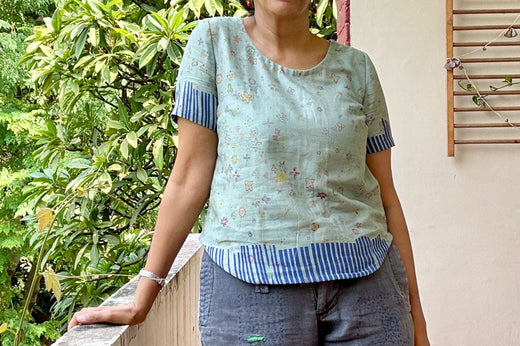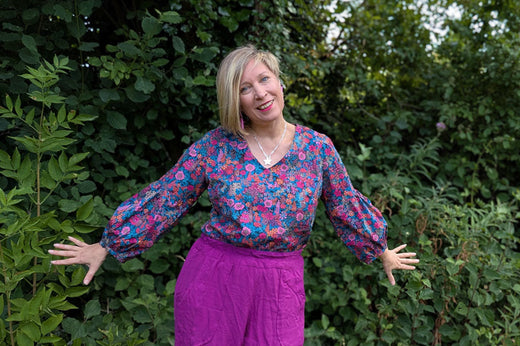Mending: love it or loathe it? How big is your mending pile? We're pleased to welcome Keavy Martin, who shares some fascinating - and relatable - reflections on the monthly Storyteller's theme "Mend". Perhaps you'll even be left feeling motivated by her call to action, and will tackle your mending pile!

Mending: we all know it’s great. So how do we actually sit down and do it?
In 2008, the British artist Jonnet Middleton made a pledge to never again acquire an article of clothing; instead, she committed to mending the clothes that were already in her closet. In the age of fast fashion, this decision aimed to usher in a new 'Age of Mending': by reconnecting with the basic sewing skills that would have been commonplace one or two generations ago, a person can reconfigure their relationship to the things that they already have. We can repair more, consume less, and so help to create more resilient and perhaps even more just textile economies - even if we do occasionally buy a new pair of socks.
Today, it seems like the Age of Mending is well on its way in - and really, in many communities, the practice of repair never ended, having always been a necessity. But now, there are dozens of high-profile sewists and artists sharing resources and other mendspiration: Instagram is full of amazing, virtuoso textile repairs.
Visible mending - often citing Japanese aesthetic traditions like boro and kintsugi - means that people are showing off their repaired clothes, celebrating holes and tears as part of the story of the garment. The capacity to wear patchy clothes and to be congratulated for it is, like everything else, inflected unjustly by markers of identity: race, class, marital status, sexuality. Collectively, though, we may be participating in a shift in how people think about textile consumption.
Through mending, many of us are noticing a deeper, more conscious relationship with the resources and materials around us; a greater respect for the labour of garment workers; even a kind of healing in this meditative chore.

But here's the twist: even though repair has so much to recommend it, it seems difficult for a lot of folks to actually get around to. I'm curious: how big is your pile of aspirational mending? (If you have have only one such pile, I congratulate you!)
Jonnet Middleton had this problem as well: apparently, even making a zero-consumption clothing pledge did not, in the end, compel her to get her mending done. "I inspire others to mend," she writes, "but can't defeat my own apathy as a victim of material abundance. Eventually, she booked herself a monthlong stay in Cuba, packed a suitcase of neglected mending, and vowed to finish it before her return. She went on to write a PhD dissertation about this problem: "that breaking keeps on happening, and mending barely happens at all."
A few years ago, I too got into mending in a big way: having never darned a sock before, the mere prospect of being able to set a tattered thing back to usefulness lit up my brain. I diligently studied WWII Board of Trade mending pamphlets and got to work. I mended everything I had, and then I sought out more mending. I was fascinated by how the practice of literal mending seemed to contain lessons for metaphorical repair, whether of one's own threadbare self, or of fraying relationships, or even of societies reeling from injustice.
I had to think carefully about my own need to 'fix' things, to prove my value, to be useful; I took a hard look at the relationship between mending and (white) virtue. Friends and neighbours started coming by with mending requests, often of beloved hand-knit items, vintage blankets.

There is something very compelling about a hole in a garment: when I meet one for the first time, it's captivating. Holey textiles can be remarkably agential: they can act upon us, we humans, propelling us to gather resources for their repair. It's as if the textile, having 'opened,' is now speaking to us in a different way.
For those of us who never grew up with sewing, the moth-hole or nail-snag becomes a kind of gateway into the vivid, collaborative, multi-species world of textile work. If I heed this initial vibrancy and sit down immediately, I can get the repair done - and with pleasure. More often than not, however, I can't do it straightaway. Into the pile it goes. At this point, my turnaround time for mending someone's sweater is probably about two years. By the time it comes back to them, they will have forgotten that it existed. Meanwhile, I may have even avoided them a little, appalled at my own negligence in attending to their special garment.
So now, on top of a pile (ahem, several piles) of mending, I have mending guilt, and mending inaction.

My fellow members of the ADHD neuro-family understand the complexities of motivation, action, and the completion of tasks. When your brain is short on dopamine, doing things is hard, and sometimes impossible. Doing things that are important - that are imbued with the stress of social relationships, of obligation - can strangely enough be even harder. We need particular conditions under which to mend: urgency helps (can you PLEASE give me a firm deadline by which to mend your sweater??), but other factors can also help make mending possible.
Sewing a beautiful garment for a loved one: this ought to be a reliable way to ensure that future mending will occur, right? For my current Twig + Tale sewing project, I am making a simple pair of Scout Pants for my 8-year-old.
In my grandma's sewing supplies was an old piece of torn-up canvas, two layers loosely quilted together. I decided that it would make good pants; however, it was white - not the ideal shade for kid clothing. And so, I spent forever collecting enough yellow onion skins and learning the basics of natural dyeing. The end result was a startling saffron textile that is certain to make a seriously robust and attractive pair of leg coverings.

Are these size 8 pants-to-be going to get shredded as my child embarks on their summer tree-climbing & slope-scrambling plans? Absolutely. Will I mend them? I really, really hope so. The investment of time, labour, and even sentimentality via inherited family materials is so extreme, my relationship with the textile so elaborate, that this garment should have a high capacity to compel me into action.
But what if this future repair, too, is avoided, delayed, and then lost in the purgatory of the mending guilt cycle? After all, what does it mean to prioritize the repair of this artisanal garment over the others - those produced via less privileged labour conditions? All textiles are made by some hands, somewhere; as such, everything is worth mending. In light of this, there is one other mending motivator that I'd recommend highly - and really, it's the most obvious one, the most tried-and-true.
For me, the single best way to get the mending done is not a Cuban vacation: it's community. Company, accountability, or 'body doubling' as we call it in ADHD land: these social structures reliably create the conditions within which mending can occur - and even be fun again. So my #1 recommendation for that pile of mending? It's the good old-fashioned stitch-and-bitch. Find the other avoidant menders and gather them. Do it once a week; do it once a month. Put out the call; bring whatever supplies, knowledge, or resources that you have. You can do it outside; you can do it online. Mending is a putting back together, a renewing of relationships: it's a beautiful way to make - and to be remade by - community.

Okay, and if you do that, can I join? I have this huge pile of mending....
Keavy Martin (she/her) is a white post-academic writer and beginner sewist who thinks about relationships to land via textiles. She lives with her husband and their 8-year-old child in Edmonton, Canada, within the territory of Treaty No. 6 and Region 4 of the Métis Nation of Alberta. You can find her @globe.thistle.
There is lots more great Storyteller content on the T+T blog! Click here to view all of the Storyteller articles.





